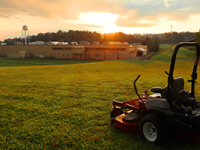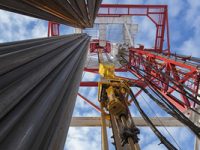Unique Team Effort Completes Upgrading of Pressure-Relief Valves at Hoover Dam
 Hoover Dam — one of the most impressive engineering feats of the 20th century – generates hydroelectricity for millions of homes and businesses across the Southwest, and it’s a constant challenge to keep the vital power source running smoothly. Recently, a team of innovative engineering experts wrapped up a massive multi-year retrofitting and refurbishing project to make the dam safer and more operationally efficient.
Hoover Dam — one of the most impressive engineering feats of the 20th century – generates hydroelectricity for millions of homes and businesses across the Southwest, and it’s a constant challenge to keep the vital power source running smoothly. Recently, a team of innovative engineering experts wrapped up a massive multi-year retrofitting and refurbishing project to make the dam safer and more operationally efficient.
Project scope and challenges
The challenge was to overhaul and upgrade a series of 50-foot-tall pressure-relief valves on turbines in the dam’s powerhouse and to convert them to a hydraulic control system. The contract for the project was awarded to Precision Machine & Supply, Inc., (a division of Andritz Hydro), which had been working with Hoover Dam since the 1990s.
“Because of the sheer complexity and logistics involved, this has been the most challenging thing I’ve ever done. It was complicated to get the old equipment out and put the new equipment in, especially with all the restrictions operating in a concrete structure at the bottom of Hoover Dam.”
Dan Wenstrom, president, Precision Machine & Supply, Inc.
 Subcontractors for the complex assignment included Parker Hannifin (led by Greg Paddock, hydraulic territory manager; Regional Manager Steve Camp; and Jeff Sage, product manager for Parker’s Accumulator and Cooler Division) and Controlled Motion Solutions, Inc., (Comoso). The Comoso team was led by Joe Oloffo, Southwest regional manager / systems integrator; Director of Engineering Matt Schoenbachler; and Jeff Geyer, fluid systems manager.
Subcontractors for the complex assignment included Parker Hannifin (led by Greg Paddock, hydraulic territory manager; Regional Manager Steve Camp; and Jeff Sage, product manager for Parker’s Accumulator and Cooler Division) and Controlled Motion Solutions, Inc., (Comoso). The Comoso team was led by Joe Oloffo, Southwest regional manager / systems integrator; Director of Engineering Matt Schoenbachler; and Jeff Geyer, fluid systems manager.
Parker was tasked with designing and manufacturing a series of compressed-gas accumulators, and Comoso was responsible for providing engineering and sourcing the hydraulic components.
Upgrading an engineering marvel

Hoover Dam is often called one of the modern wonders of the world. Standing over 700 feet tall and containing more than 3,250,000 cubic yards of concrete, the magnificent structure spans the Colorado River between Nevada and Arizona, forming the 247-square mile Lake Mead reservoir behind it.
The dam generates more than 4 billion kilowatt-hours of electricity each year by taking diverted river water from the lake, under extremely high pressure, and channeling it into giant turbines at its base. The water to drive the turbines is fed by gravity through a series of large pipes called penstocks, which narrow (from 30 feet to 13 feet) as they descend to increase the pressure on the water being forced through. When the incoming water reaches this point, its pressure is 250 psi.
At the bottom of the penstocks, the water then enters the turbine through large steel wicket gates, each over six feet tall and weighing 1,500 pounds. The gates work like Venetian blinds, opening and closing to control the volume of water going into the turbine. As water rushes through the wicket gates, it passes over blades that spin the turbine and drive a rotor inside a generator, which then creates a magnetic field to produce electricity.
Hoover Dam has 17 turbines, each weighing about 700 tons, with generator shafts rotating at 180 rpm. While a turbine is spinning, energy is constantly being created and fed through power lines. However, if there is a sudden break or fault in the line – also called a load rejection – the turbine needs to stop as quickly as possible.
When a rejection takes down a primary line – which can be caused by a lightning strike or actual physical damage to a transmission wire — there’s no place for that newly generated electricity to go. If that happens, the spinning turbine tends to overspeed, which can cause serious damage to the mechanism. Therefore, the water driving it has to be immediately shut off at the gates and simultaneously diverted around the turbine. However, that necessity comes with problems of its own.
First, if the high-pressure water flow is stopped too abruptly, it results in a powerful “water hammer” effect when the backed-up pressure suddenly and violently slams into an obstruction. (Imagine trying to bring a fast-moving train to an immediate stop.) The water delivery system at Hoover Dam contains kinetic energy to reduce the life of the penstocks.
Diverting the flow and relieving pressure
To avert the dangers of those sudden load rejections, the original designers of Hoover Dam installed large pressure-relief valves (PRVs) which could quickly reroute incoming water to bypass the turbines, thereby taking the generators offline. The first PRVs utilized water head pressure to drive large pistons to close tulip valves.
In recent years, though, questions arose about the original PRVs’ functional consistency and ability to protect the aging water lines. Installation of the turbines at the dam began in 1936, so the equipment and infrastructure inside the power plant were naturally affected by time and use.
“The turbines and all their plumbing are vintage – 80 years old in some cases – with a lot of wear and tear on them. So the Hoover people were very concerned about pressure spikes and the resulting negative impact they could have on the equipment.”
Greg Paddock, territory manager, Parker Hydraulics
“Over the years, those pressure-relief valves became corroded, agreed Wenstrom. “Also, the original valves were mechanically actuated and water-operated, because that’s all the technology they had in the 1930s.”
Developing the solution
 Aware of the critical need to optimize the reliable performance of the older pressure-relief valves, the operations team at Hoover Dam launched a long-term project to upgrade them. The main objective was to make the PRVs more responsive and functionally efficient when a power line break would necessitate a generator shutdown.
Aware of the critical need to optimize the reliable performance of the older pressure-relief valves, the operations team at Hoover Dam launched a long-term project to upgrade them. The main objective was to make the PRVs more responsive and functionally efficient when a power line break would necessitate a generator shutdown.
The initial plan called for overhauling the existing valves by taking them apart and restoring worn components to like-new condition. The scope of the challenge – plus the restriction of not being able to shut down multiple turbines at the same time – meant the work would inevitably require many years to complete. Hoover’s plant personnel and Precision Machine began the first remedial work on the valves in 1998 and 1999.
While that work was underway, Wenstrom came up with a unique design concept to standardize operation of the PRVs and make them digitally controlled. The dam’s original generating equipment was built by various manufacturers and installed over a long span of years, so it was far from consistent. There are five separate turbine designs in operation at Hoover Dam. Even units built by the same manufacturer several years apart had differences.
“We showed Hoover a design that would make the units fully compatible with their existing electronic control system that operated and controlled the generators. We proposed converting all PRVs to be operated in the same way and all controlled by hydraulic cylinders.”
Dan Wenstrom, president, Precision Machine & Supply, Inc.
The decision was made to go with hydraulic-driven pressure-relief valves which could provide very precise control and extremely fast response. The system would also reduce the number of false pressure relief valve operations that often occurred with the old mechanically operated PRVs. Wenstrom brought in Comoso to engineer and supply the hydraulic power unit and manifold that mounted to the hydraulic cylinder.
Auxiliary power needed
The hydraulic controls also required accumulators for energy back-up. Parker’s Accumulator and Cooler Division — a world leader in the development of customized accumulator applications — was given the assignment to design the best units for Hoover Dam’s unprecedented requirements. Working closely with Comoso and Precision, Parker was able to implement an ideal, cost-effective solution. An accumulator enables a hydraulic system to respond quickly to a temporary demand, using a less powerful pump.
“Think of the accumulators as very large batteries with high levels of energy to operate the PRVs. The accumulator stores hydraulic energy until it’s needed for immediate use.”
Jeff Sage, product manager, Accumulator and Cooler Division, Parker Hannifin Corporation
Supplemental power from the accumulators is necessary because of how Hoover’s hydroelectric equipment is configured. Ironically, available electricity is very limited inside the huge power-generating facility.
“Where the PRVs are located in the dam, there isn’t much access to electrical power, said Camp. “The dam puts out 185,000 horsepower per turbine, but we only had the equivalent of ten horsepower in the area where we worked.”
The power that’s available inside the dam itself comes from two smaller separate generators called “house units” in the powerhouse. The little units simply wouldn’t have the energy capacity to operate multiple high-pressure, high-horsepower hydraulic oil pumps to drive the cylinder when a PRV trips.
“The accumulators instantaneously allow 750 to 900 horsepower, so we have the energy we need at the drop of a hat to operate the valves. It opens the bypass very quickly.”
Steve Camp, regional manager, Parker Hannifin Corporation
Each pressure-relief valve at Hoover Dam now utilizes one compressed gas piston accumulator with pressurized oil (180 gallons under 2,750 psi) and two large nitrogen-gas bottles. The accumulators have a 20” bore and an outside diameter of 23 5/8”. They’re 200″ long and have a dry weight of 8,653 lbs. A total of seventeen accumulators and thirty-four nitrogen gas bottles have been installed.
“It was a huge challenge, and not many manufacturers can build accumulators of this size,” Paddock noted, “but Parker Hannifin was up to the task.”
Outstanding results

“As the upgraded PRVs are designed, we now get shaft movement typically within less than a tenth of a second after the signal is received that the generator is going into emergency shutdown,” said Paddock. “As quickly as the (water intake) gates are closing, the PRV has to open to bypass the same amount of water that was otherwise going through the turbine. That’s within ten seconds. And then the most critical aspect of it is once the PRV is fully open, it has to slowly reclose so that no water hammer is created.”
With the installation of each new pressure-release valve, a commissioning team – including representatives from Hoover Dam, Precision Machine, Comoso, and Parker Hannifin – conducts a very detailed testing process.
“To do the commissioning, we bring the generator up to speed and then trip it to simulate an emergency shutdown, Wenstrom explained. “Recording devices with transducers on the turbine side and the PRV side precisely measure the hydraulic pressures, the strokes, and the time it takes the cylinder to respond to the emergency closure signal. Then we measure the amount of time it takes the pressure-relief valve to open and to reclose. The whole idea is that these PRVs have to open very quickly, as soon as the wicket-gate starts to close, to avoid a water hammer.”
Bonus benefits
In addition to dramatically improving the functionality and reliability of the PRVs, the hydraulically driven system provides a solution to a new problem at Hoover Dam: Quagga mussels.
An invasive species of Quagga mussels had made its way into the Colorado River and Lake Mead, and by 2009 the mussels actually started plugging up water passageways in the dam’s control valve system. They clog PRVs by clinging to the rods that open and close the valves, and in some cases even prevented them from opening.
“Dan’s design to modernize the PRVs ensured they would operate regardless of any fouling factors such as the Quagga mussels,” said Paddock. “The hydraulic-driven PRV could basically just plow through any obstruction in its path, by brute force. The impetus of the conversion to the hydraulic design wasn’t the mussels, but it turned out to be a great secondary benefit.”

“There are many long-term benefits to this whole project, from operational efficiency to safety and more,” said Paddock. “Parker is grateful to have been part of it.”
 Article contributed by Parker Hannifin led by Greg Paddock, hydraulic territory manager; Steve Camp, regional manager; and Jeff Sage, product manager, Accumulator and Cooler Division.
Article contributed by Parker Hannifin led by Greg Paddock, hydraulic territory manager; Steve Camp, regional manager; and Jeff Sage, product manager, Accumulator and Cooler Division.


Other related articles for you:
Theme Park Thrills Owe Much to Hydraulics and Accumulators
How to Specify the Proper Sized Heat Exchanger for Your Hydraulic System
Hydraulic Accumulator Services Improve Plant Equipment Efficiency
Hydraulic Power Units Control All Functions of Hydro-electric Turbine
Source: Parker Feed





